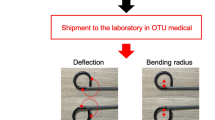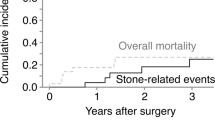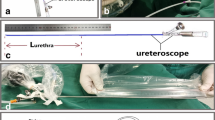Abstract
Several studies of ureteroscopic treatment for ureteral stones have reported that most stone clearance failures can be attributed to stone fragment retropulsion. Stone retropulsion can result in increased operative time and cost—resulting from the need to change from the semi-rigid ureteroscope to a flexible instrument to chase migrated calculi—and additional procedures to treat residual migrated fragments are often required. The degree of migration depends mainly on the energy source used for lithotripsy; pneumatic and electrohydraulic lithotripters are associated with a greater degree of retropulsion than lasers. Different stone-trapping strategies and devices have been developed to minimize stone migration. Novel devices include the Lithovac® suction device, the Passport™ balloon, the Stone Cone™, the PercSys Accordion®, the NTrap®, and stone baskets such as the LithoCatch™, the Parachute™, and the Escape®. Some authors have also reported on the use of lubricating jelly and BackStop® gel (a reverse thermosensitive polymeric plug); these devices are instilled proximal to the stone prior to the application of kinetic energy in order to prevent retrograde stone migration.
Key Points
-
Retrograde stone retropulsion is relatively common during the endoscopic management of proximal ureteral calculi (28–60% incidence) and distal calculi (3–15% incidence), regardless of lithotripter type
-
The use of an antiretropulsion device is essential when dealing with proximal ureteral calculi or calculi with proximally dilated ureter
-
The choice of antiretropulsion device should be based on the type of ureteroscopy, type of lithotripter, ureteral diameter, and surgeon experience
-
For patients with proximally dilated ureters, the 10 mm Stone Cone™ and 10 mm PercSys Accordion® device seem to be associated with greater clinical success than other devices
-
For patients with distal ureteric stones, routine use of an antiretropulsion device could reduce mean operative time and increase stone-free rates
-
Further efforts are still required to produce a safe and effective antiretropulsion device, as well as a lithotripsy energy source with lower retropulsion rates
This is a preview of subscription content, access via your institution
Access options
Subscribe to this journal
Receive 12 print issues and online access
$209.00 per year
only $17.42 per issue
Buy this article
- Purchase on Springer Link
- Instant access to full article PDF
Prices may be subject to local taxes which are calculated during checkout






Similar content being viewed by others
References
Preminger, G. M. et al. 2007 Guideline for the management of ureteral calculi. Eur. Urol. 52, 1610–1631 (2007).
Kijvikai, K. et al. Shock wave lithotripsy or ureteroscopy for the management of proximal ureteral calculi: an old discussion revisited. J. Urol. 178, 1157–1163 (2007).
Wu, C. F. et al. Therapeutic options for proximal ureter stone: extracorporeal shock wave lithotripsy versus semirigid ureterorenoscope with holmium:yttrium-aluminum-garnet laser lithotripsy. Urology 65, 1075–1079 (2005).
Hendrikx, A. J. et al. Treatment for extended-mid and distal ureteral stones: SWL or ureteroscopy? Results of a multicenter study. J. Endourol. 13, 727–733 (1999).
Bagley, D. H. Expanding role of ureteroscopy and laser lithotripsy for treatment of proximal ureteral and intrarenal calculi. Curr. Opin. Urol. 12, 277–280 (2002).
Pardalidis, N. P., Kosmaoglou, E. V. & Kapotis, C. G. Endoscopy vs. extracorporeal shockwave lithotripsy in the treatment of distal ureteral stones: ten years' experience. J. Endourol. 13, 161–164 (1999).
Chow, G. K. et al. Ureteroscopy: effect of technology and technique on clinical practice. J. Urol. 170, 99–102 (2003).
Knispel, H. H. et al. Pneumatic lithotripsy applied through deflected working channel of miniureteroscope: results in 143 patients. J. Endourol. 12, 513–515 (1998).
Osorio, L. et al. Emergency ureteroscopic management of ureteral stones: why not? Urology 69, 27–31 (2007).
Leveillee, R. J. & Lobik, L. Intracorporeal lithotripsy: which modality is best? Curr. Opin. Urol. 13, 249–253 (2003).
Tunc, L. et al. Pneumatic lithotripsy for large ureteral stones: is it the first line treatment? Int. Urol. Nephrol. 39, 759–764 (2007).
Lee, H. et al. Stone retropulsion during holmium:YAG lithotripsy. J. Urol. 169, 881–885 (2003).
Dretler, S. P. The stone cone: a new generation of basketry. J. Urol. 165, 1593–1596 (2001).
Delvecchio, F. C. & Preminger, G. M. Management of residual stones. Urol. Clin. North Am. 27, 347–354 (2000).
Rane, A., Sur, R. & Chew, B. Retropulsion during intracorporeal lithotripsy: what's out there to help? BJU Int. 106, 591–592 (2010).
el-Gabry, E. A. & Bagley, D. H. Retrieval capabilities of different stone basket designs in vitro. J. Endourol. 13, 305–307 (1999).
Kesler, S. S. et al. Use of the Escape nitinol stone retrieval basket facilitates fragmentation and extraction of ureteral and renal calculi: a pilot study. J. Endourol. 22, 1213–1217 (2008).
Delvecchio, F. C., Kuo, R. L. & Preminger, G. M. Clinical efficacy of combined lithoclast and lithovac stone removal during ureteroscopy. J. Urol. 164, 40–42 (2000).
Dretler, S. P. Ureteroscopy for proximal ureteral calculi: prevention of stone migration. J. Endourol. 14, 565–567 (2000).
Dellabella, M. et al. Rapid, economical treatment of large impacted calculi in the proximal ureter with ballistic ureteral lithotripsy and occlusive, percutaneous balloon catheter: the high pressure irrigation technique. J. Urol. 178, 929–933 (2007).
Maislos, S. D. et al. Efficacy of the Stone Cone for treatment of proximal ureteral stones. J. Endourol. 18, 862–864 (2004).
Desai, M. R. et al. The Dretler stone cone: a device to prevent ureteral stone migration—the initial clinical experience. J. Urol. 167, 1985–1988 (2002).
Pardalidis, N. P., Papatsoris, A. G. & Kosmaoglou, E. V. Prevention of retrograde calculus migration with the Stone Cone. Urol. Res. 33, 61–64 (2005).
Gonen, M. et al. Efficacy of dretler stone cone in the treatment of ureteral stones with pneumatic lithotripsy. Urol. Int. 76, 159–162 (2006).
Eisner, B. H. & Dretler, S. P. Use of the Stone Cone for prevention of calculus retropulsion during holmium:YAG laser lithotripsy: case series and review of the literature. Urol. Int. 82, 356–360, 2009.
Springhart, W. P. et al. Use of Stone Cone minimizes stone migration during percutaneous nephrolithotomy. Urology 67, 1066–1068 (2006).
Holley, P. G. et al. Assessment of novel ureteral occlusion device and comparison with stone cone in prevention of stone fragment migration during lithotripsy. J. Endourol. 19, 200–213 (2005).
Percutaneous System, Inc. PercSys Accordian stone management device document [online].
Olbert, P. J. et al. Efficacy and safety of the Accordion stone-trapping device: in vitro results from an artificial ureterolithotripsy model. Urol. Res. 38, 41–46 (2010).
Eisner, B. H., Pengune, W. & Stoller, M. L. Use of an antiretropulsion device to prevent stone retropulsion significantly increases the efficiency of pneumatic lithotripsy: an in vitro study. BJU Int. 104, 858–861 (2009).
Feng, C. et al. Use of NTrap during ureteroscopic Holmium:YAG laser lithotripsy of upper ureteral calculi. Minim. Invasive Ther. Allied Technol. 21, 78–82 (2011).
Wang, C. J., Huang, S. W. & Chang, C. H. Randomized trial of NTrap for proximal ureteral stones. Urology 77, 553–557 (2011).
Rane, A. et al. The use of a novel reverse thermosensitive polymer to prevent ureteral stone retropulsion during intracorporeal lithotripsy: a randomized, controlled trial. J. Urol. 183, 1417–1421 (2010).
Ali, A. A. et al. A novel method to prevent retrograde displacement of ureteric calculi during intracorporeal lithotripsy. BJU Int. 94, 441–442 (2004).
Mohseni, M. G., Arasteh, S. & Alizadeh, F. Preventing retrograde stone displacement during pneumatic lithotripsy for ureteral calculi using lidocaine jelly. Urology 68, 505–507 (2006).
Zehri, A. A. et al. A randomized clinical trial of lidocaine jelly for prevention of inadvertent retrograde stone migration during pneumatic lithotripsy of ureteral stone. J. Urol. 180, 966–968 (2008).
Percutaneous System, Inc. PercSys Accordion CoAx® stone control device document [online].
Pagnani, C. J., El Akkad, M. & Bagley, D. H. Prevention of stone migration with the Accordion during endoscopic ureteral lithotripsy. J. Endourol. 26, 484–488 (2012).
Ding, H. et al. NTrap in prevention of stone migration during ureteroscopic lithotripsy for proximal ureteral stones: a meta-analysis. J. Endourol. 26, 130–134 (2012).
Farahat, Y. A., Elbahnasy, A. E. & Elashry, O. M. A randomized prospective controlled study for assessment of different ureteral occlusion devices in prevention of stone migration during pneumatic lithotripsy. Urology 77, 30–35 (2011).
Chew, B. et al. Anti-retropulsion devices increase stone fragmentation efficiency with Holmium:YAG laser lithotripsy. Urology 78, S376 (2011).
Lee, H. J. et al. In vitro evaluation of nitinol urological retrieval coil and ureteral occlusion device: retropulsion and holmium laser fragmentation efficiency. J. Urol. 180, 969–973 (2008).
Ouwenga, M. K. et al. Load-release points of two novel ureteral stone-trapping devices. J. Endourol. 19, 894–897 (2005).
Ahmed, M. et al. Systematic evaluation of ureteral occlusion devices: insertion, deployment, stone migration, and extraction. Urology 73, 976–980 (2009).
Boccafoschi, C. & Lugnani, F. Intra-renal reflux. Urol. Res. 13, 253–258 (1985).
Suh, L. K. et al. Intrarenal pressures generated during deployment of various antiretropulsion devices in an ex vivo porcine model. J. Endourol. 24, 1165–1168 (2010).
Marguet, C. G. et al. In vitro comparison of stone retropulsion and fragmentation of the frequency doubled, double pulse nd:yag laser and the holmium:yag laser. J. Urol. 173, 1797–1800 (2005).
Jiang, H. et al. Ureteroscopic treatment of ureteral calculi with holmium: YAG laser lithotripsy. J. Endourol. 21, 151–154 (2007).
Finley, D. S. et al. Effect of holmium:YAG laser pulse width on lithotripsy retropulsion in vitro. J. Endourol. 19, 1041–1044 (2005).
Abdelsayed, M., Onal, E. & Wax, S. H. Avulsion of the ureter caused by stone basket manipulation. J. Urol. 118, 868–870 (1977).
Durano, A. C. & Hanosh, J. J. Jr. A new alternative treatment for entrapped stone basket in the distal ureter. J. Urol. 139, 116–117 (1988).
Author information
Authors and Affiliations
Contributions
Both authors contributed towards researching, discussing, writing, reviewing, and editing the article.
Corresponding author
Ethics declarations
Competing interests
The authors declare no competing financial interests.
Rights and permissions
About this article
Cite this article
Elashry, O., Tawfik, A. Preventing stone retropulsion during intracorporeal lithotripsy. Nat Rev Urol 9, 691–698 (2012). https://doi.org/10.1038/nrurol.2012.204
Published:
Issue Date:
DOI: https://doi.org/10.1038/nrurol.2012.204
This article is cited by
-
Thulium-Doped Fiber Laser and Its Application in Urinary Lithotripsy
Journal of Medical and Biological Engineering (2023)
-
A new position utilizing the effect of gravity in proximal ureteral stones, ureteroscopic lithotripsy in the reverse Trendelenburg position: a prospective, randomized, comparative study
World Journal of Urology (2023)
-
Evaluation of ultrathin semirigid ureteroscopy in terms of efficiency and cost compared to flexible ureteroscopy in treating proximal ureteric stones: a prospective randomized multicenter study
World Journal of Urology (2023)
-
Impact of forced diuresis on retropulsion of disintegrated ureteral calculi during semi-rigid ureteroscopy: a double-blind randomized-controlled study
Urolithiasis (2022)
-
Retropulsion force in laser lithotripsy—an in vitro study comparing a Holmium device to a novel pulsed solid-state Thulium laser
World Journal of Urology (2021)



